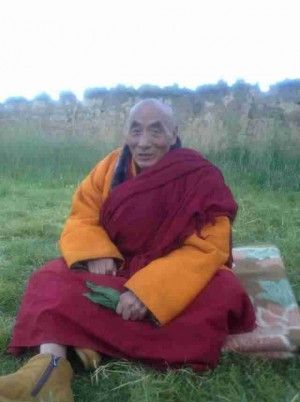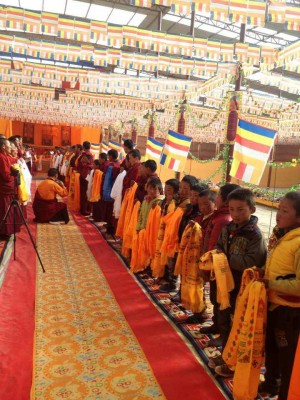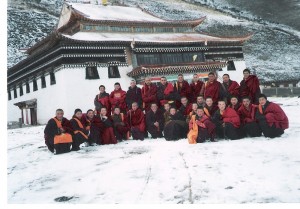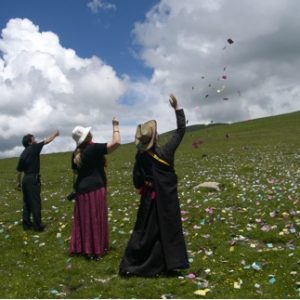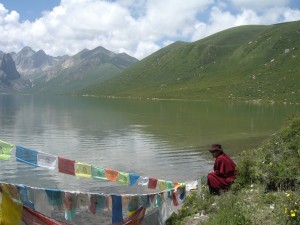Pictures of recent celebrations at Tayang for the Abbot’s 80th Birthday.
The actual Ta Yang Monastery is quite young; only about 35 years. Previously people from Vasser went to the area, put up their tents, received teachings from traveling lamas, stayed “on retreat” for a week, a month, or more, and then packed up their tents and went home, or back to their mother monastery.
The Head Monastery, and one of the, if not the, largest Monastery in Golok is Tarthang. This is only a few days’ ride away from Vasser. But the people of Vasser decided they needed a Monastery of their own, and gave land on which to build.
This picture shows the older monks in front of their Gompa (meditation hall)
[divider]
Vasser Monastery
Some time after the Golok nation was originally born (from the daughter of a King of Amdo and a serpent, in the Lake Nyimpo Yertzeh, the King of Golok gave his son a “New Tent”. “Vas” means tent in the local language, and “ser” means new. This actually refers to people, property, and autonomy. The people of Vasser were therefore given independence, could promulgate new laws, etc. In our understanding, it would probably be rather like a Shire being given autonomy of a sort from the State, so you could say that Vasser was a Shire of Golok. Of course, this is many centuries ago, and things are very different now.
The Monastery is generally known as Ta Yang. This is named after the large Mountain behind it, called Ta Yang. There is a Guardian living in Ta Yang and she is the guardian of the Vasser people. The Lap Tseh that proliferate in the area, at Mountain passes and snaking up the hills, are offerings to the Guardian. They are made up primarily of prayer flags. As one passes, one throws Lung ta (Windhorse symbols) into the air towards the Guardian, to supplicate for good luck and success and safety. The lung ta have the symbol of a horse with a jewel on its back. This represents the air element, and as you throw the flags, your fortunes are taken up in the wind and fly to the Guardian on the air.
So that is the meaning of both names – Vasser Monastery, and Ta Yang Monastery, and is how we, the Ta Yang Guardians, chose our name.
[divider]
The Abbot
Also known as “Mirror Rinpoche”, the Abbot of Ta Yang, Lobsang Tsultrim Rinpoche, was born in 1935. A delightful, wise lama, he is very well educated and a powerful and respected master of many lineages, mainly Nyingma and Dzogchen (which Ta Yang is) and Gelug, but remains simple, humble and kind.

The role of the Abbot in a Tibetan Buddhist Monastery is to teach.
Until 1974 Mirror Rinpoche was Abbot of Tarthang Monastery where he gave many teachings. During the Chinese repression he spend many years studying and practicing underground, and in 1974 he moved to Vasser to take over Ta Yang Monastery, in order to be nearer his family and take care of them. It is said that when his mother died, he promised never to reject a request, and to everyone’s knowledge, he never has.
His main practice is Tara and there are frequently many monks visiting Vasser to obtain teachings from him. He is especially famous for his ability in divination.
There are two types of divination “Mo” (dice) and “Dha” (mirror).
Mirror Rinpoche received all the instructions and empowerments so that he could discriminate and understand correctly these messages. How does he do this? He performs his practice, then asks for your question. He then throws rice at a mirror and interprets the visions and symbols that appear in the mirror. He then dedicates this activity. Some of the Ta Yang Guardians were fortunate enough to have personal divinations from Mirror Rinpoche, and although they were not all positive, they were, at least so far, totally accurate.
Thupten Rabgyi Lama
Rabgyi is about 35 years old (he is not sure as, there are no birth certificates issued for this region at the time) and was born in Vasser, in a nomad tent in which his mother still lives. He went to the Vasser Monastery when it was still only a tent community. He moved to Tharthang, the Head Monastery, where he spent many years, some of them as Geko for 500 monks. The Geko administers the Monastery and the discipline of the monks
He went to Nepal at the age of 25 and then on to India where he spent six months in Refugee school. He spent the next roughly seven years between Nepal and India, including Bir Monastery, Bodghya, Dharamsala and Ladakh. He arrived in Australia in 2003 with a scholarship from Namkhai Norbu Rinpoche, the head of the international Dzogchen community.

